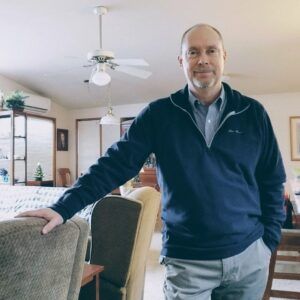Last year, our nation changed, and conservation districts were affected because we are part of society. It changed on May 25, 2020, with the killing of George Floyd and the subsequent outcry across the country about police brutality, police racism, and lack of police accountability. That event sparked awareness and a much wider conversation about diversity, equity, and inclusion (DEI).
Below, I summarize the high points of our journey as WACD engaged in DEI-related conversations and activities in our conservation district community. I close with my reflections on our actions and progress made to date, in full recognition that this journey is not over.
National Association of Conservation Districts
Your National Association of Conservation Districts responded to these concerns quickly, with the July 2020 statement by the NACD Board of Directors on diversity, equity, and inclusivity:
The Washington Association of Conservation Districts was honored to be asked to participate in an NACD DEI Task Force to help develop proposed next steps in implementing NACD’s policy statement. WACD Executive Director Tom Salzer represented WACD on the Task Force. The Task Force produced a report that was subsequently accepted by the NACD Board of Directors:
After completing their report, the NACD DEI Task Force was reformed as the NACD DEI Special Committee, chaired by NACD First Vice President Kim LaFleur. WACD is an active participant on the Special Committee which has been meeting regularly since it was formed.
Washington Association of Conservation Districts
In recognition of the wide range of feelings in our conservation district community, and in contrast to NACD’s quick response, WACD moved much more slowly. Our conversations about DEI have been heralded as long overdue, criticized as unnecessary, or perceived as blaming or threatening. Some people see DEI as primarily a race-based issue. Others see DEI being inclusive of a much wider population that includes race along with other factors.
As the feelings of our members began to become more evident in 2020, WACD’s leadership chose to become better informed before taking action. Leadership chose to be responsive, not reactive. WACD listened to conversations throughout the summer and fall of 2020, and in particular, during annual meetings of area associations.
Some resolutions emerged during 2020 area association meetings that touched on or spoke directly to DEI. Two resolutions were passed by a majority of voting members at the 2020 WACD annual business meeting. While resolution 2020-05 was widely supported, resolution 2020-06 was passed by one vote.
Resolution 2020-05 was titled Diversity, Equity & Inclusion Statement & Work Plan Development:
WACD will convene a committee to develop a Diversity, Equity, and Inclusion policy recommendation by September 2021. This recommendation will be provided to all Conservation Districts for consideration at their Area Meetings with action by the WACD at its annual meeting. The Committee will also provide information, suggested resources, and guidance for districts that are interested in developing their own diversity, equity, and inclusion initiatives.
Resolution 2020-06 was titled Diversity, Equity & Inclusion Statement:
WACD will create a DEI Committee that will consider the following actions and develop any recommendations by September 2021 to all Conservation Districts for consideration at their Area Meetings for possible action by the WACD at its annual meeting.to include but not limited to the following:
1 – The Commission and WACD help conservation districts to work with underrepresented communities in their service area to understand what natural resource concerns are important to them and to find ways to incorporate those natural resources concerns into the conservation district’s book of business.
2 – To encourage conservation districts to prioritize equity in the services they offer and in employment decisions.
3 – That the Commission and WACD organize annual diversity, equity, and inclusion seminars that are made available to all Conservation District Supervisors and Managers.
4 – That WACD and the Commission work with districts to make elections more public and to ensure that communities of color are engaged around elections.
5 – That the commission recruits and retains a diversity, equity, and inclusion officer that will work with the election’s officer to promote engagement of communities of color across the state and address the disparity gap around services and elections.
6 – That WACD asks conservation districts and the Washington State Conservation Commission to take actions to encourage more diversity in conservation district supervisor positions both elected and appointed.
In response to the two resolutions adopted by members, WACD leadership found that both could be addressed through the work of a single workgroup. Recognizing that these resolutions placed important issues before WACD, and knowing that our members were not uniform in their interest or support, WACD chose to invest in a facilitated process. Many other organizations were also looking for facilitators experienced in the DEI space so procuring such services took a bit longer than expected.
The Committee on Diversity, Equity, and Inclusion (CDEI) was formed in spring 2021 with representation from all six area associations in Washington State. Following several facilitated sessions to help the group work effectively together, work commenced on addressing resolutions 2020-05 and 2020-06. The CDEI completed its work in September 2021 with the production of a draft policy statement and a draft set of recommendations:
- WACD DEI policy statement - DRAFT - R2020-05 (779 downloads )
- WACD recommendations - DRAFT - R2020-06 (686 downloads )
I am deeply appreciative of the sincerity exhibited by all members of the CDEI. While our conversations were not always comfortable, they were informative and we found common ground on several points. I expect that the WACD Board of Directors will ask that CDEI members consider continuing their work as WACD shifts toward implementing the policy statement and the recommendations of the CDEI.
Area Associations of Conservation Districts
The two work products of the CDEI were made available in time for all six area association meetings this year. WACD has requested feedback on the draft policy statement and the draft recommendations but to date, no written feedback has been received.
WACD meetings
WACD Board of Directors meetings
The CDEI’s work products will be reviewed by the WACD Board of Directors at their work session on Monday, October 18, 2021. WACD staff will collect feedback throughout October and prepare a summary for the Board to consider at their regular meeting on Monday, November 15. I am sure that the Board will entertain comments on these documents from members during their regular meeting in November. I don’t know whether the Board will choose to act on the draft policy and recommendations or whether they will wish to see resolutions so that the will of WACD members can be more clearly expressed.
WACD Annual Business Meeting
At the WACD Annual Business Meeting, WACD will report whether the WACD Board of Directors has taken any actions with regard to the draft policy and the draft recommendations.
Once all of the annual meetings are over and the WACD Board of Directors has decided what to do, we will dive into revising WACD’s annual work plan so that any needed steps are incorporated into the plan.
My perspective

Over the past year-and-a-half, WACD officers, directors, and staff have witnessed a range of reactions as DEI became part of our daily language in conversations throughout Washington State. We’ve seen an entire rainbow of reactions, from passionate advocacy to stubborn denial. We’ve heard anger, frustration, delight, and demands. I have not found any two people who feel exactly the same about DEI.
Looking back over my 30 years in our conservation district community, this lack of unity is not uncommon. It has happened many times before. What makes DEI different is that it touches many of our people very deeply. It cuts deeper than just what program to fund or what practices to put on the ground. What we have encountered is an aspect of our larger society that has intersected with how conservation districts are accountable to their constituents as they work to recognize, prioritize, fund, and fix natural resource issues.
Sometimes we may not think about the impacts of particular natural resource situations on others who may be downstream, upwind, or even in another conservation district. Keeping soil on the farm helps the farmer, but it also helps people who live downstream. It helps those who can be affected by airborne dust. In the context of conservation district work, part of equity is recognizing that many more people benefit from the work that conservation districts do…and since they are affected, shouldn’t they be included in the processes that eventually lead to obtaining funding and implementing needed conservation practices?
At the pragmatic level of daily conservation district operations, that’s really what DEI is about: including those who may be affected by our work (or by the choice to work somewhere else) so that they have a voice in how and where conservation is implemented.
I do wish we could use a term other than DEI. I have found that it sets off a cascade of emotions with some folks, and once triggered, they have trouble hearing the ideas and feelings of others and then responding thoughtfully. Whenever the terms discrimination and equity have come up, someone in the room has felt like they were being accused of being evil or doing something wrong. While I know it is a bit silly to “rename the baby,” I can’t help but think this conversation would have been easier, and perhaps more productive, if earlier conversations had revolved around how to include more people in our conservation work. Inclusion is an action step. By taking that step we can begin to address diversity and equity.
I prefer to focus on the future rather than the past. I can’t change the past but I can invest in doing better today and in every tomorrow that follows. Conservation districts are clearly future-focused, selecting conservation practices that will improve conditions now and for future generations. This aspect of our conservation district community resonates deeply with me.
I’ll close with two quotations that illustrate my leaning toward the future:
“The best way to predict the future is to create it.” Abraham Lincoln
and
“The future starts today, not tomorrow.” Pope John Paul II
Always yours for conservation,
Tom Salzer, WACD Executive Director
We appreciate your feedback. Send your thoughts to feedback@wacd.org
